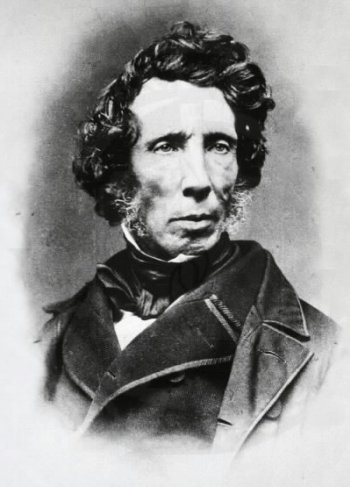Friedrich Wöhler
Friedrich Wöhler (July 31, 1800 - September 23, 1882) was a German chemist, best-known for his synthesis of urea, but also the first to isolate several of the elements.
Early days
He was born in Eschersheim, nowadays a district of Frankfurt am Main. In 1823 Wöhler finished his study of medicine in Heidelberg at the laboratory of Leopold Gmelin, who arranged for him to work under Jöns Jakob Berzelius in Stockholm. He taught chemistry from 1825 to 1831 at the Polytechnic School in Berlin; then till 1836 he was stationed at the Higher Polytechnic School at Kassel, and then he became Ordinary Professor of Chemistry in the University of Göttingen, where he remained till his death.
Contributions to chemistry
Wöhler is regarded as a pioneer in organic chemistry as a result of his (accidentally) synthesizing urea in the Wöhler synthesis in 1828. Until 1828, it was believed that organic substances (i.e., protoplasm) could only be formed under the influence of the vital force in the bodies of animals and plants. Wöhler proved by the artificial preparation of urea from inorganic materials that this view was false. Urea synthesis was integral for biochemistry because it showed that a compound known to be produced only by biological organisms could be produced in a laboratory, under controlled conditions, from inanimate matter. This in vitro synthesis of organic matter disproved the common theory (vitalism) about the vis vitalis, a transcendent "life force" needed for producing organic compounds. By showing that ammonium cyanate can become urea by an internal arrangement of its atoms, without gaining or losing in weight, Wöhler furnished one of the first and best examples of isomerism, demolishing the old view that equality of composition could not coexist in two bodies, A and B, with differences in their respective physical and chemical properties. In the year of his urea synthesis, Wöhler became professor at the age of 28. Two years later, in 1830, Wöhler published, jointly with Justus von Liebig, the results of a research on cyanic acid and cyanuric acid and on urea. Berzelius, in his report to the Royal Swedish Academy of Sciences, called it the most important of all researches in physics, chemistry, and mineralogy published in that year. The results were quite unexpected, and furnished additional evidence in favour of isomerism.
Major works, discoveries and research

Wöhler was also a co-discoverer of beryllium and silicon, as well as the synthesis of calcium carbide, among others. In 1834, Wöhler and Liebig published an investigation of the oil of bitter almonds. They proved by their experiments that a group of carbon, hydrogen, and oxygen atoms can behave like an element, take the place of an element, and can be exchanged for elements in chemical compounds. Thus the foundation was laid of the doctrine of compound radicals, a doctrine which had a profound influence on the development of chemistry.
Since the discovery of potassium by Humphry Davy, it had been assumed that alumina, the basis of clay, contained a metal in combination with oxygen. Davy, Oerstedt, and Berzelius attempted the extraction of this metal, but failed. Wöhler then worked on the same subject, and discovered the metal aluminium. To him also is due the isolation of the elements yttrium, beryllium, and titanium, the observation that "silicium" (silicon) can be obtained in crystals, and that some meteoric stones contain organic matter. He analyzed a number of meteorites, and for many years wrote the digest on the literature of meteorites in the Jahresbericht der Chemie; he possessed the best private collection of meteoric stones and irons existing. Wöhler and Sainte Claire Deville discovered the crystalline form of boron, and Wöhler and Buff the hydrogen compounds of silicon (the silanes) and a lower oxide of the same element.
Final days and legacy
Wöhler's discoveries had great influence on the theory of chemistry. The journals of every year from 1820 to 1881 contain contributions from him. It was remarked that "for two or three of his researches he deserves the highest honor a scientific man can obtain, but the sum of his work is absolutely overwhelming. Had he never lived, the aspect of chemistry would be very different from that it is now." [citation needed]
While sojourning at Cassel, Wöhler made, among other chemical discoveries, one for obtaining the metal nickel in a state of purity, and with two friends he founded a factory there for the preparation of the metal.
Wöhler had several students who became notable chemists. Among them were Heinrich Limpricht, Rudolph Fittig, Adolph Wilhelm Hermann Kolbe, Georg Ludwig Carius, and Vojtěch Šafařík.
Works
| Wikimedia Commons has media related to Friedrich Wöhler. |
- Lehrbuch der Chemie, Dresden, 1825, 4 vols.
- Grundriss der Anorganischen Chemie, Berlin, 1830
- Grundriss der Organischen Chemie, Berlin, 1840
- Praktische Übungen in der Chemischen Analyse, Berlin, 1854
References
- Brigitte Hoppe (2007). "Review of The life and work of Friedrich Wohler (1800-1882) by Robin Keen, edited by Johannes Buttner". Isis. 98 (1): 195–196.
- George B. Kauffman, Steven H. Chooljian (2001). "Friedrich Wöhler (1800–1882), on the Bicentennial of His Birth". The Chemical Educator. 6 (2): 121–133. doi:10.1007/s00897010444a.
ar:فريدرش فولر bg:Фридрих Вьолер cs:Friedrich Woehler de:Friedrich Wöhler eo:Friedrich Wöhler fa:فردریش ولر it:Friedrich Wöhler he:פרידריך ולר hu:Friedrich Wöhler nl:Friedrich Wöhler sk:Friedrich Wöhler sl:Friedrich Wöhler sr:Фридрих Велер sv:Friedrich WöhlerHI!